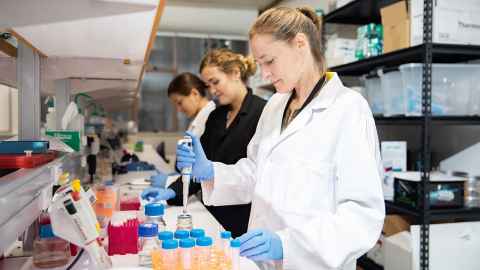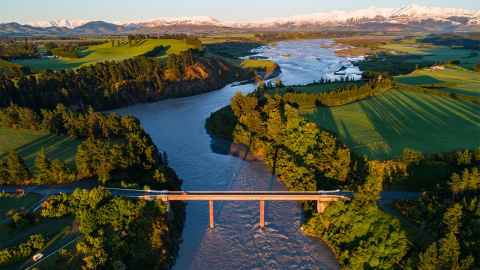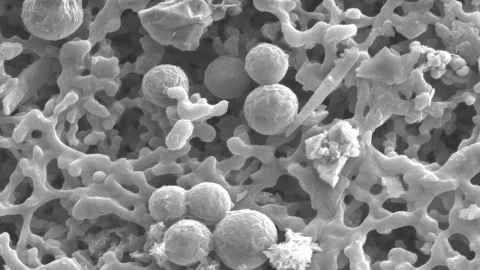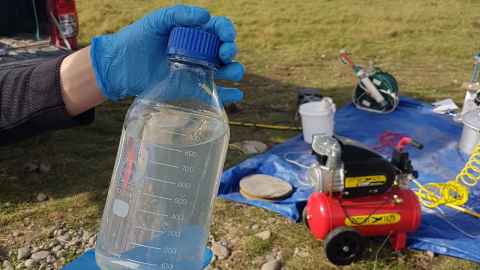The secret life of our aquifers
21 April 2020
Drinking water for 40 percent of New Zealanders comes from aquifers, which also feed rivers and lakes. But nitrogen is tainting Aotearoa’s groundwater. What’s that pollution doing to the complex microbial eco-systems down there?



It’s the 700 billion cubic metre taonga that nobody can see. The treasure is groundwater, stored in aquifers and replenished from rainfall filtered through layers of earth, rock and gravel. The surprise is how little we know about this resource under our feet.
Microbiologist Kim Handley, of the University of Auckland, is changing all that. Delving into an underground world, she’s discovering previously unknown microbe communities in the water.
That’s helping to flesh out an updated version of Charles Darwin’s tree of life – and may provide clues on mitigating pollution.
What’s at stake is groundwater from 200 aquifers that flows into rivers and lakes, irrigates land, and provides drinking water for an estimated 40 percent of the population, including people who live in Christchurch, Wanganui, Napier, Hastings, and Lower Hutt. The annual value of the water for irrigation alone is estimated at $2 billion.

The most pervasive threat is from nitrate that leaches into the water. Handley and her team are tackling three key tasks.
First, working out what’s living down there. (Plot spoiler: Bacteria, mainly.) Second, figuring out the microbes’ roles in the nitrogen cycle, potentially gaining clues on how the critters could help to mitigate pollution woes.
Third, assessing how these underwater eco-systems could be used to monitor pollution. The backdrop is a worldwide pollution threat as nitrate from fertiliser runoff kills fish, triggers toxic algal blooms, and renders drinking water undrinkable. In New Zealand, a dairying boom has contributed to nitrate seeping into our rivers, streams – and aquifers. Canterbury is a focus of concern as home to both the nation’s biggest reserves of groundwater and no fewer than 1.3 million dairy cows at last count.
“We’re lucky in New Zealand because our nitrate contamination is not as bad as in other countries,” says Kim Handley, “But it’s creeping up in places, and some of our groundwater is not safe to drink. We need to get on top of it.”
In a three-year project, Handley, doctoral students Olivia Mosley and Emilie Gios, and collaborators including Dr Louise Weaver of the Institute of Science and Environmental Research, and Dr Karen Houghton, of crown research institute GNS, are concentrating on two alluvial aquifers in Canterbury, on the Central Plains and the Waimakariri-Ashley plains, and sampling wells across Auckland, Wellington and the Waikato at a total of 59 sites.

"There's this whole world down there of all these fascinating little creatures."
While water from the earth might seem the definition of 100 percent pure, the samples contain not just pollution but also an array of tiny living creatures, thousands of times smaller than a grain of sand. The scientists filter water pumped from farmland, reserves, industrial and urban settings – even, in one case, in a carpark by a McDonald’s in Wellington – and studying biofilms, build-ups of microbes stuck to the sediment.
Making the most of global advances in metagenomics – where researchers sequence DNA from environmental samples without needing to culture creatures in the lab – they’ve discovered more than 550 never-before-identified microorganisms. “There’s this whole world down there of all these fascinating little creatures,” Handley says.
A key question is what role each one plays in the nitrogen cycle, which sees the chemical – which makes up most of the air we breathe – moving between different forms, such as organic nitrogen, ammonium, nitrite, nitrate, nitrous oxide, nitric oxide and nitrogen gas as it circulates between the atmosphere and organisms.
“We’re only just starting to understand how the bacteria transform pollutants,” says Handley. “They can mitigate the problem, or they can create another problem, like turning potentially toxic nitrate into a greenhouse gas, nitrous oxide.”
There are some bizarre creatures down there – like Planctomycetes bacteria, which create hydrazine, a highly toxic compound used in rocket fuel. Also present: worm-like nematodes, small crustaceans, and single-celled organisms called archaea that have found fame for often being “extremophiles,” living in hydrothermal vents, glacial ice, or toxic waste dumps.

From a pollution viewpoint, the good news is that groundwater microorganisms appear “surprisingly resilient” to large differences in aquifer chemistry and nitrogen levels, Handley says.
Changes in the abundance of different types of microbes – a shuffling in the order of what’s present in the greatest numbers – may serve as an indicator of nitrogen pollution and degraded aquifer conditions, she says.
One objective is to lay the foundations for an ecological health index, similar to the macroinvertebrate community index used to monitor pollution levels in rivers by checking on the likes of insects, worms and snails.
The New Zealand scientists’ work contributes to the modern understanding that the tree of life, described by Darwin in On the Origin of the Species, is dominated by neither animals nor plants, but, rather, bacteria. The New Zealand work is adding to studies in Colorado – where Handley previously carried out research - and Germany that are unveiling the complexity of the ecosystems in water underground. The samples of water that the scientists are studying here vary from essentially pristine to those loaded with nitrate levels 2.5 times higher than the maximum level allowed in drinking water.
That maximum permissible level – 11.3 milligrams per litre – is intended to prevent methemoglobinemia, or 'blue baby ‘syndrome, a rare but life-threatening condition for bottle-fed infants where the ingestion of nitrate ultimately disrupts the transport of oxygen to the tissues.
In 2016, the World Health Organization said the weight of evidence did not ‘clearly’ support an association between nitrate in drinking water and the risk of cancer. However, despite WHO’s position, epidemiological studies have pointed to associations with elevated risks of bowel and other cancers and birth problems such as very premature babies, very low birth weights and neural tube defects.
Groundwater nearest the surface may be three to 10 years old, while deeper down the age may be 100 years, and deeper still, 1000 years.
A 2018 study from Denmark, published in the International Journal of Cancer, grabbed attention in New Zealand for reporting a link between nitrate in water and the risk of bowel cancer, based on a study of 2.7 million people over 33 years. New Zealand’s bowel cancer rate is one of the highest in the world, the second-highest cause of our cancer deaths – and has its highest incidence in South Canterbury.
After a wave of media attention, a government working group chaired by the Ministry of Health’s chief science advisor, Dr Ian Town, is carrying out an initial brief review of international research and New Zealand data on nitrate in water.
Nitrate above natural levels has been detected in more than 30 percent of New Zealand’s monitored bores. While officials and farmers are working to mitigate the problem, the nation’s big switch to high-intensity dairy farming means easy fixes are hard to come by.
There are also pollution time-lag effects as water circulates through the environment. In Canterbury, groundwater nearest the surface may be three to 10 years old, while deeper down the age may be 100 years, and deeper still, 1000 years.
Adding to the complications, climate change is set to alter the country’s rainfall and evaporation patterns, altering water flows. "When you’ve got an incredibly important resource that’s poorly understood and not necessarily well managed, you’ve got a threat,” says Dr Chris Daughney, a Ministry for the Environment scientist who helped initiate Handley’s project. “That’s why this research is so important.”
For Handley, understanding the capacity for groundwater communities to remove nitrogen from water will be a big advance. From this knowledge, she and the team, along with other researchers, can begin to develop the guidelines to ensure groundwater eco-systems stay healthy and recover from nitrogen pollution.
Researchers elsewhere have trialled ways to slow the rate of nitrogen pollution by building trenches through which groundwater passes, where water is treated with organic carbon to stimulate the natural microbial communities to remove nitrogen. This is feasible on a small scale, and the outcomes of the research here will help inform these types of targeted remedial projects.
However, Handley says, “The scale and complexity of our aquifers really means it makes more sense to keep our aquifers healthy through better policies and management of the sources of pollution."
Story by Paul Panckhurst
Researcher portrait: Billy Wong
The Challenge is a continuing series from the University of Auckland about
how our researchers are helping to tackle some of the world's biggest challenges.
To republish this article please contact: gilbert.wong@auckland.ac.nz